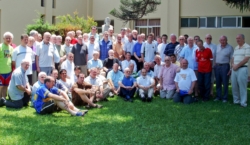From Cardinal Seán’s blog
This year the Missionary Society of St. James the Apostle is celebrating the 50th anniversary of its foundation. Last week, I traveled to Peru to be a part of some of the celebrations and special events that are taking place there.
I stayed at their center house in Barranco, a section of Lima. Not only were the men currently serving with the society present, also many of the former members of the St. James Society as well, including Father Jim Ronan and Bishop Robert Hennessey.
I gave a keynote address on evangelization, and there were a number of other talks.
Priests spoke about the situation of the Church, the history of the society and projections for the future. Father Patrick Byrne, SVD, the secretary of the Holy Childhood Association, gave a very interesting talk about his international organization, founded in 1843 and dedicated to fostering awareness of the missionary nature of the Church among children. There was also an address by the retired Bishop of Sicuani, Msgr. Albano Quinn, about the repercussions of the influx of foreign missionaries in the local communities.
Archbishop Antonio Arregui Yarza, the archbishop of Guayaquil, Ecuador was also there at the center house with us, and celebrated one of the Masses.
On Sunday, the apostolic nuncio to Peru presided over a Mass in the neighborhood of El Salvador, one of the pueblos jóvenes. Bishop Hennessey delivered the homily at the Mass.
Pueblos jóvenes are shanty towns inhabited by squatters who have come down from the mountains and the rural areas. In fact, millions of them have simply set up shacks on the sand dunes. Because of the Humboldt Current, the cold ocean current that extends along the West Coast of South America, it does not rain along the coast.
One evening, I was able to arrange to take the Boston priests out for dinner in Miraflores, a suburb of Lima that is right on the water. I was very surprised to see how modern the shopping center in which the restaurant was located was. The situation in Peru is slightly calmer now than it has been historically, and there have been some positive developments in the economy. Unfortunately, the country still has some of the poorest areas in the hemisphere, and, as I understand it, also one of the largest rates of illiteracy among its population.
Over the last 50 years, the society has typically assisted rural and very poor urban parishes. After bringing them up to a certain level, the society then turns them over to the local dioceses and moves on to other challenging areas.
Over the course of its history, about 300 priests have participated in the work of the St. James Society. Originally, Cardinal Cushing sent down a large group to begin the work. Early on, the practice was that a priest would serve a certain number of years, let’s say five, and then return to his diocese. This was a great blessing for us because many of the men who worked in the St. James Society returned to Boston and then became involved in Hispanic ministry here at a time when more and more Spanish-speaking people were coming from Puerto Rico and the Caribbean.
In more recent years, the tendency has been for fewer men to go but to stay for longer periods of time. Cardinal Cushing saw this as a society that was open to inviting all diocesan priests to be a part of it. Although Boston is always the largest participant, there has been a history of priests coming from Ireland, England and Scotland. At the present time, there are many priests serving in the St. James Society from Ireland. There is also an Australian priest and one from New Zealand and the most recent additions have been two priests from the Philippines.
Msgr. Finbarr O’Leary, director of the society, recently reorganized the board of directors, and there is great hope for the future. We are always inviting priests in Boston and other diocesan priests from different places in the United States to consider being a part of this very valuable missionary experience.
The society has given the Catholics of Boston a great sense of the Church’s missionary nature because each summer the priests from St. James come back and preach in many of our parishes. This is not only a way of collecting money for the apostolate and the works of mercy that the St. James Society sponsors in Peru, Ecuador and Bolivia, but it also exposes the Catholics of the archdiocese to the larger Church and to the needs of the Church, the Mission ad Gentes.
Also in this post:
> Tickets for New York papal Mass
> The passing of Father Daniel Kennedy
> Sister Olga’s return from Iraq



















